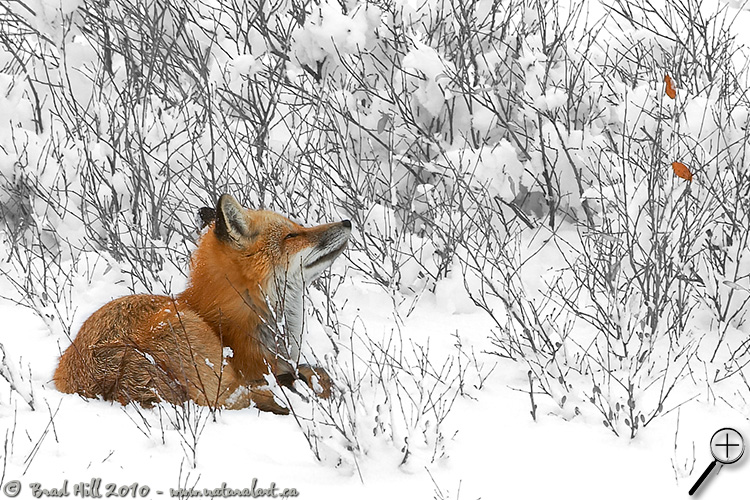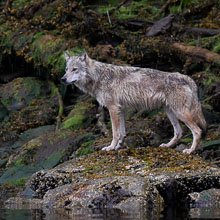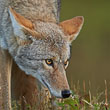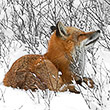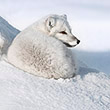Availability: Limited Edition Print; RM Stock (??)
In the Field
Red Fox - Contemplation. Cape Churchill, MB, Canada. October 25, 2004.
If an animal has ever looked content and contemplative, this Red Fox would be it! Despite the visual brilliance of its coat, over much of its geographic range the Red Fox blends in quite well with its habitat. But not on the snow-covered tundra - here the Red Fox stands out like a sore thumb! When we first encountered this particular fox it was sound asleep. It was only after a wait of at least 20 minutes that the fox woke and slowly looked up. When its gaze appeared to stop on the orange willow leaves I snapped the shutter and captured the moment. By the way, there was a good reason for this fox to look so content: it had killed, partially consumed, and cached an adult Arctic Fox shortly before this image was captured!
Alert - Digitally Manipulated Image: This image clearly crosses the line from simple digital correction to digital manipulation. I desaturated the colour of the burgundy-coloured willow stems to draw attention to the two key elements of the image that share the same colour - the fox and the leaves.
It is my policy to clearly identify ANY images on this website that overstep the bounds of digital correction and enter the territory of digital manipulation (see Voice: Commentary: Digital Correction vs. Digital Manipulation).
Behind the Camera
Red Fox - Contemplation. Cape Churchill, MB, Canada. October 25, 2004.
Digital Capture; Compressed RAW (NEF) format; ISO 200.
Nikon D2H with Nikon 200-400 mm f/4G ED-IF AF-S VR lens @ 400 mm (600 mm equivalent with digital conversion factor) supported on bean bag. VR turned to "On" and in "Normal" mode.
1/125s @ f11; +0.7 stop exposure compensation from matrix-metered exposure setting.
At the Computer
Red Fox - Contemplation. Cape Churchill, MB, Canada. October 25, 2004.
RAW Conversion to 16-bit TIFF, including first-pass sharpening and tone curve adjustment, using Phase One's C1 Pro.
All further digital correction on 16-bit TIFF file using Adobe's Photoshop CS, including selective saturation enhancement, selective desaturation, and selective sharpening for web output.
Conservation
Red Fox - Contemplation. Cape Churchill, MB, Canada. October 25, 2004.
Ten percent of the revenue generated by this image will be donated to the Yellowstone to Yukon Conservation Initiative.
Species Status in Canada*: Not "Threatened" or "Endangered".
The Red Fox (Vulpes vulpes) has the widest geographic distribution of any member of the order Carnivora and is found throughout the northern hemisphere. Its range is estimated to cover 70 million sq. km. As such, it is far from endangered. Interestingly, it has been documented that the Red Fox is expanding its range northward in Canada and elsewhere, and it is possible that this geographic expansion is related to global warming. This northward range expansion appears to be coming at the expense of the smaller and less aggressive Arctic Fox. The Red Fox out-competes the Arctic Fox for food (and for denning sites) and is a severe predator of juvenile Arctic Foxes. Indeed, the Red Fox pictured here has a reason to look content - it had killed, partially consumed, and cached an adult Arctic Fox shortly before this image was captured!
The Yellowstone to Yukon (Y2Y) Conservation Initiative seeks to ensure that the world-renowned wilderness, wildlife, native plants, and natural processes of the Yellowstone to Yukon region continue to function as an interconnected web of life, capable of supporting all of its natural and human communities, for current and future generations.
*as determined by COSEWIC: The Committee on the Status of Endangered Wildlife in Canada












